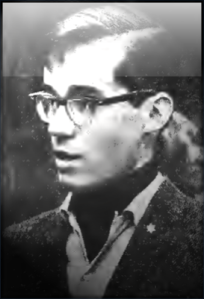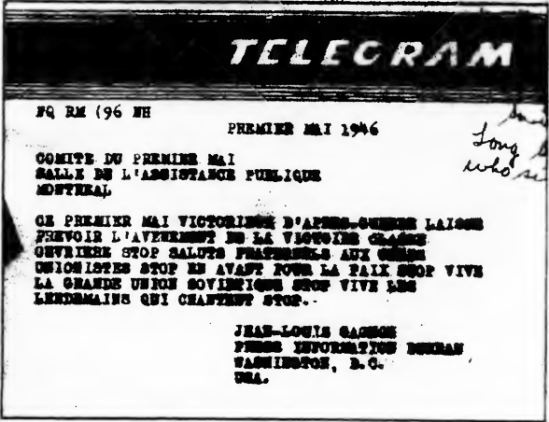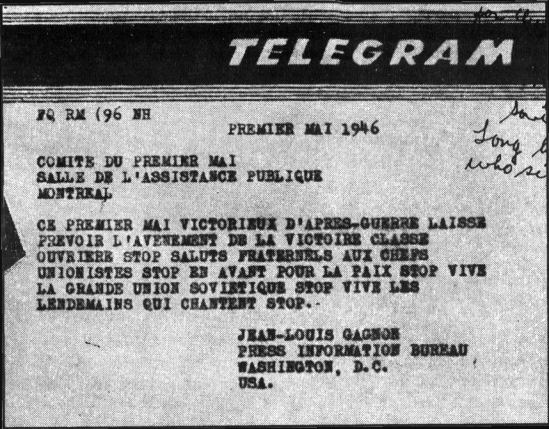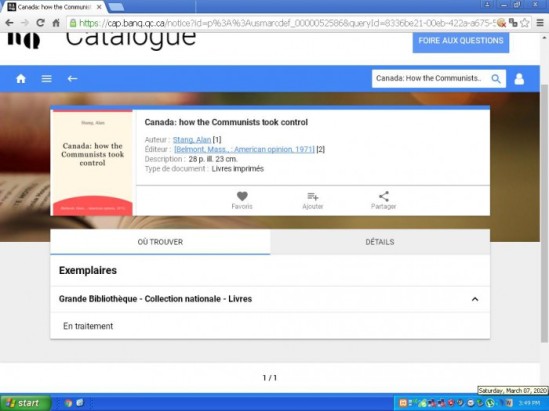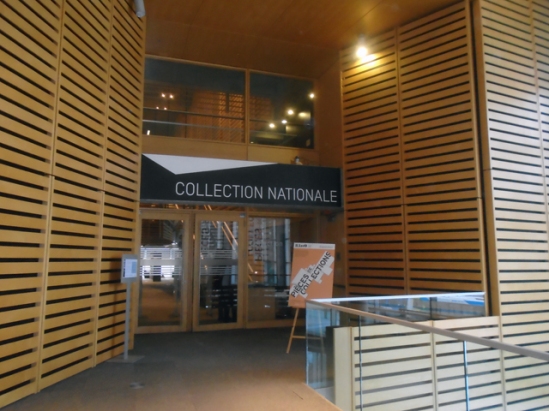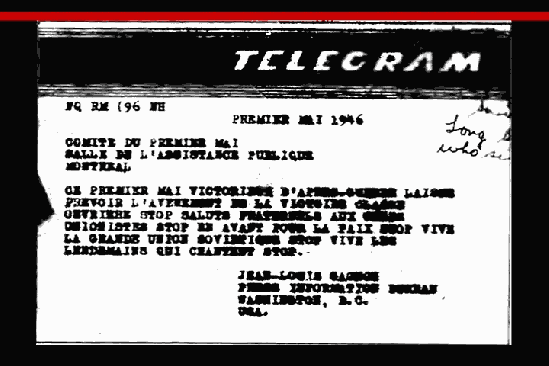Part II:
The Fromm-Proos attack on Alan Stang
1971
- Alan Stang: CANADA How The Communists Took Control
- F. Paul Fromm, 1967, University of Toronto (in The Varsity).
Referring to Alan Stang’s article in the April 1971 American Opinion (“Canada How The Communists Took Control”), Fromm’s writer, Januus Proos, says:
“A telegram, reproduced on the article’s centerfold, reputed to have been sent by Jean-Louis Gagnon is an outright forgery. A similar telegram was sent but not this one. Which brings up the point, that by carelessly using false information that can be disproved, Stang has afforded the enemy the opportunity to discredit the remaining 99% fact in the article.”
However, Proos did not go on to “disprove” the reality of the telegram that Stang had published “in the centerfold”. Nor did Proos “disprove” any other facts alleged by Stang, including the fact that Pearson had been outed to the FBI as a Soviet agent by Elizabeth Bentley, defecting from Soviet military intelligence.
Why did Proos say “A similar telegram was sent but not this one”? Why did Proos not disprove the alleged Stang “forgery” by noting that Straight Talk! itself had published the real telegram sent by Gagnon, also in April 1971. Why not say, here’s the real one! We published it!
Perhaps because EBS readers might have noticed the one Fromm had published is identical to the one Stang had published that Proos called an “outright forgery”.
if we are to believe Proos that Stang published an “outright forgery”, something that Proos and Fromm certainly would not do (right?), Fromm would have published the REAL telegram, or else, the consequence, according to Proos denouncing Stang, would be to DISCREDIT “the remaining 99% fact”, and this time, not merely in a single article, but in the whole of the supposedly expert anti-communist journal of Paul Fromm, StraightTalk!
So, either Fromm’s EBS published the same “forgery”; and both telegrams are “outright forgeries”, or both telegrams are authentic, and Proos and Fromm had falsely accused Alan Stang of publishing a forgery. In fact, the latter is the case. Fromm and Proos lied about Stang. What would the effect be of that kind of a lie? It would discredit Stang and drive him off Canadian turf, where the Communist operation has long been well underway on the street, and inside government.
Fromm and Proos published an authentic May-Day Telegram by Soviet agent Jean-Louis Gagnon. It’s absolutely identical to the one that Stang published. We will see this clearly down below with a line-by-line graphic demonstration, proving that Stang did not publish a forgery.
It happens that in 1971, the original author of the telegram, known Soviet agent Jean-Louis Gagnon, was employed by Pierre Trudeau in Information Canada; as noted by Stang who points to Gagnon’s pro-Soviet May-Day telegram.
Stang correctly observes the high concentration of communist agents in the federal government of Canada, including Pierre Trudeau, Jean-Louis Gagnon, and Lester Bowles Pearson himself, outed by Bentley in the U.S. McCarran hearings.
Stang planned a mass-mailing to warn Canadians of a Communist takeover from the top-down, inside the federal government of Canada.
That mass-mailing was a threat to Fromm’s main boss, Lester Pearson, for whom Canada’s national police had recruited F. Paul Fromm to set up the Edmund Burke Society as a national surveillance and police front in February of 1967.
That mass-mailing was a threat as well to Pierre Elliott Trudeau, another Communist who jointly bossed Canada’s national police with Pearson, and who therefore also was Paul Fromm’s boss. Stang’s planned mass-mailing was a threat to the top-down Communist operation in Canada.
Surely, Stang had to be frightened away. Falsely accusing him of publishing a forgery, while telling him to stick to his own side of the border, was the public method chosen.
To prove to you that Fromm published the same telegram that Stang published in April 1971, I will compare the two published telegrams and you can see for yourself that they are identical.
Here is the May-Day Telegram of Communist Party member, Jean-Louis Gagnon, published by Fromm top-right on page 7 of Straight Talk! in April, 1971 (Volume III, No. 7):
Straight Talk!
April, 1971 (Volume III, No. 7)

The Telegram published by Fromm, top-right on page 7
of Straight Talk! in April 1971, Volume III, No. 7.
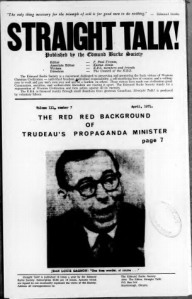
“The Red Red Record of Trudeau’s Propaganda Minister” (Jean-Louis Gagnon), Straight Talk!, April 1971
The picture of the telegram in Straight Talk! with a caption under it, isolated on a page by itself, is a clumsy way to begin a cover story on the infamous May-Day Telegram of Jean-Louis Gagnon, praising the “Great Soviet Union”. The caption (the fine print) begins the story, which continues in larger dark print in the middle of the page, and then says “continued page 8)”.
The bottom-third of page 8 begins: “(THE RED, RED RECORD OF TRUDEAU’S MINISTER OF PROPAGANDA, continued from page 7)”. The expose says “Former R.C.M.P. undercover agent, Pat Walsh, knew Gagnon was the right-hand man in Quebec to Soviet spy and former member of Parliament, Fred Rose.” And it goes on to end in the top-fourth of page 9.
Indeed, Pat Walsh, in his 1982 pamphlet, “Inside the Featherbed File? Canada’s Watergate, The Story of Treason in Ottawa“, in the segment “Comintern Penetrates Federal Civil Service” says:
“… the Royal Commission Report dealing with Soviet espionage in the ’40s revealed that other Soviet spies active in the External Affairs Department had either fled the country (Jean-Louis Gagnon fled to Brazil, with the cooperation of Mitchell Sharp, then a director of Brazilian Traction Corporation) or could not be positively identified because only their code names were known.”
See, also, “The Jean-Louis Gagnon Case” in that same article.
The Telegram from Straight Talk!, enlarged
The telegram published by Fromm as authentic:
The Telegram from American Opinion, enlarged
The telegram published by Stang as authentic:
Above is the May Day Telegram of Communist Jean-Louis Gagnon published by Alan Stang in American Opinion top-left on page 14 in April, 1971.
The Telegram Stang published in April 1971 — denounced by Fromm and Proos as being an “outright forgery” — is in fact part of the April 1971 cover story of Paul Fromm’s Straight Talk! while Fromm is the editor. Fromm is responsible for publishing this Telegram as authentic to denounce Jean-Louis Gagnon as a Soviet agent.

The bill for the Alan Stang offprint.
Above-left is the bill for the offprint. Fromm, who is outed by me as a Communist agent working to overthrow Canada (we’ll see a few of his efforts in Part III of this article), can come and shoot me. My address is right on the bill, the bill is authentic. Invoice by Willis Monie – Books, 139 Main Street, Cooperstown, NY 13326. Date of invoice 10/29/19. “Stang – Canada”. Amount: $5.00, Shipping: $10.00, Total: $15.00.
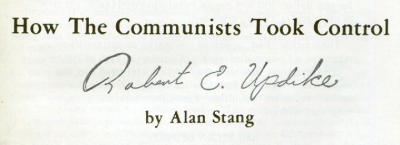
Robert E. Updike (signature) on Stang’s ““Canada” offprint, 1971
The particular offprint once belonged to Robert E. Updike, whose signature was on the cover (see above). The original offprint has been donated to the Quebec Archives. I removed the signature from the scan of the “Canada” offprint online here, at the present web site. And that is all I removed.
The Telegram in the centerfold of Stang’s
“Canada” offprint (top-left) April 1971
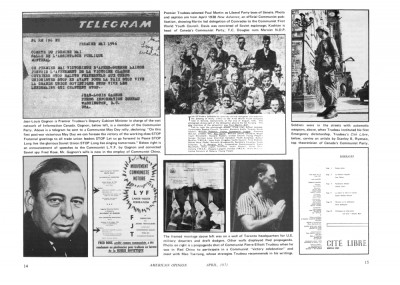
The Telegram, top-left in the double-page spread in the center-fold of Stang's Canada offprint of April 1971.
The Telegram, top-left in the double-page spread in the center-fold of Stang’s Canada offprint of April 1971.[/caption]
Preparing to compare the Stang and Fromm Telegrams
First, here’s how I prepared the two publications of the Telegram to prove they are one and the same. I purchased a clean copy of Alan Stang’s CANADA How The Communists Took Control and scanned the Telegram. I sized the scan to match a print-screen of the same Telegram in Straight Talk! online at archive.org, taken from the scan made by the Thomas Fisher Rare Books Library. The Fisher describes itself at archive.org: “The Thomas Fisher Rare Book Library is a library in the University of Toronto, constituting the largest repository of publicly accessible rare books and manuscripts in Canada.”
I put both copies of the Telegram into MovieMaker in Windows XP Pro and used an automatic “wipe” transition with a red bar to gradually reveal one telegram, line by line, overlaid on the other. I save the video, then I shot stills from the video and assembled them as a gif in ulead gif animator (free edition: it’s quirky, but it works). You can thus read the two telegram images one line at a time, top to bottom, to see for yourself that the telegrams are identical.
After scanning the Stang pamphlet, I donated the original to the Quebec Archives, whose rare books department gladly accepted it as an authentic original offprint. Mr. Daniel Chouinard, Librarian in charge of acquisitions over on 2275 Holt Street in Montreal, acknowledged receipt in email, on 11/11/2019, in French, as follows:
“RE: Alan Stang, CANADA How The Communists Took Control (1971)
Bonjour Madame,
J’ai bien reçu l’exemplaire de la brochure intitulée Canada : How the Communists Took Control.
Je vous remercie de ce don qui contribuera à enrichir notre collection.
Cordiales salutations.
Daniel Chouinard
Bibliothécaire
Direction du dépôt légal et des acquisitions
Direction générale de la Bibliothèque nationale
Bibliothèque et Archives nationales du Québec2275, rue Holt
Montréal (Québec) H2G 3H1Téléphone : 514 873-1101, poste 3740
Sans frais : 1 800 363-9028
Télécopieur : 514 873-7286
daniel.chouinard@banq.qc.ca
http://www.banq.qc.ca”
Translation: “I received the copy of the brochure entitled Canada: How the Communists Took Control. / Thank you for this donation which will contribute to enriching our collection.”
The document is now in the BAnQ’s catalogue, with the words “en traitement” bottom-left. That’s French for “it’s being processed” to make it publicly available in the collection. The words above that, “Grande Bibliothèque – Collection nationale – Livres” mean the “book” or document is in the Rare Books Division, through this portal:
We now can be sure we are looking at “Stang’s” copy of the telegram from an actual, meaning authentic, copy of American Opinion.
Now, let’s compare them.
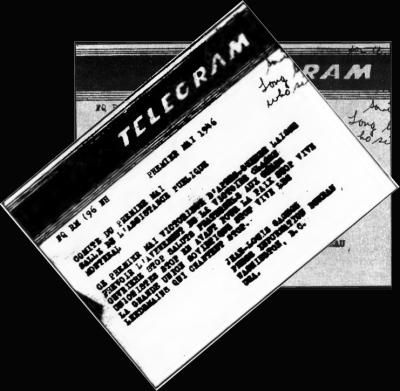
I will lay the EBS (white) telegram over the Stang (grey) telegram, and then remove the white one, a line at a time, to reveal the grey one, proving both are identical.
The scan of the Stang Telegram is grey to aid comparison. The animated gif below gradually exposes Stang’s grey telegram by removing Fromm’s white telegram laid over it.
You can therefore see, the Telegrams are identical.
There is no doubt Paul Fromm as editor of Straight Talk in April 1971, published an outright lie by Januus Proos while accusing Alan Stang of publishing “an outright forgery”: for, if Stang published a “forgery”, then so did Paul Fromm.
The Telegram: Stang -vs- Fromm
Top-down wipe done in Moviemaker in XP Pro
Fromm and Proos lied savagely
Fromm and Proos lied savagely, even risking exposure of their own publication of the same Telegram, to avert Stang’s mass-mailing that might have exposed Canada’s top-down Communist operation.
Fromm, himself, would also have been exposed as one of their agents.
Q.: Why was Fromm concerned about
Stang’s mass-mailing?
A.: It would have been a Big Success!
Let me return you to my wrap-up of PART I of this multi-part article on FROMM and the EBS as a national police front under Soviet Agent Pearson and Communist PIerre Elliott Trudeau. Click that link and scroll down to read my sum-up entitled “CONCLUSION – Part I”, where I prove to you that a prior mass-mailing by Ron Gostick, in which FROMM himself participated with the EBS, was a massive success.
And that is why F. Paul FROMM, and his writer Janus PROOS, smeared American patriot ALAN STANG in Straight Talk! in 1971: to prevent a similar “major conservative grass-roots upsurge” and a top-down clean-out of the communist-penetrated federal government of Canada, including the exposure of little red FROMM, himself.
F. Paul Fromm, who set up the Edmund Burke Society as a police front for Soviet agent Lester Bowles Pearson, and who also worked for Communist mole Pierre Elliott Trudeau, and reported to Trudeau’s red Solicitor General of Canada in charge of the national police and national security of Canada, Jean-Pierre Goyer from December 22, 1970 to November 26, 1972, is a Communist agent.
As V.I. Lenin said: “We’ll run our own opposition”.
F. PAUL FROMM is controlled opposition.
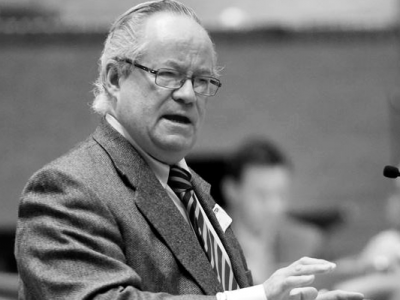
F Paul Fromm, Communist Agent
… To be continued.


